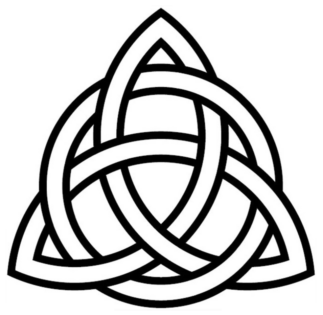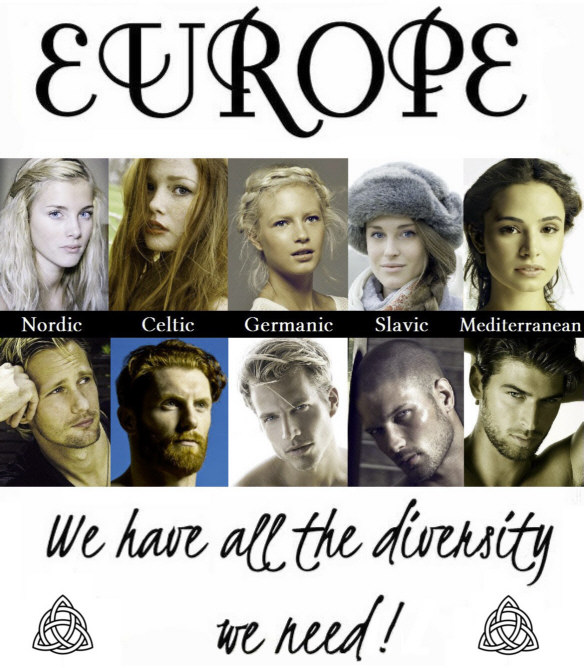
|
|
MANKIND QUARTERLY 2011 51:4 471-489 |
|
White BeautyExcerpts from ‘Race and Advertising’Lee Ellis and Ping He |
|
With the assumption that fashion models and manikins are considered highly attractive, the present study recorded the race of models and manikins publically displayed in city malls in China, Malaysia, and the United States. Caucasian (white, European) models were found to be mainly utilized in all three countries, especially in regard to clothing fashion displays. |
Support for the idea that people throughout the world use very similar criteria when judging physical attractiveness has come from newborns. In these studies, babies less than a week old were shown photographs on television or computer monitors that were previously rated by adults in terms of physical attractiveness. Babies were allowed to control the length of time they viewed each photograph, usually by sucking on a pacifier whenever they wanted to move to another image. All of these studies revealed that, on average, infants spent more time viewing the photographs that adults rated highest in attractiveness (Geldart, Maurer, & Henderson 1999; Kramer, Zebrowitz, San Giovanni, & Sherak, 1995; Langlois, Roggmann, Casey, Ritter, Rieser-Danner, & Jenkins, 1987; Samuels, Butterworth, Roberts, Graupner, & Hole, 1994; Samuels & Ewy, 1985).
Added support for the idea that there are more or less universal standards of human facial beauty comes from a study by Jones and Hill (1993). They compared the judgments of physical attractiveness made by people in five cultures (Brazil, United States, Russia, Ache, and Hiwi). Results indicated that the females who were considered most attractive in all five cultures tended to exhibit exaggerated neotenous (infant-like) traits, such as large eyes, small noses, and full lips (also see Jones, 1995; Kramer, Zebrowitz, San Giovanni, & Sherak, 1995).
A final line of evidence came from comparing models used in women’s magazines in three countries – Singapore, Taiwan, and the United States. Working from the perspective that judgments of attractiveness are ethnocentrically based, Frith, Cheng, and Shaw (2004, p. 56) tested the hypothesis that “Asian models would be used more frequently in Asian magazines, and Western models would be used more frequently in U.S. magazine advertisements.” Contrary to this hypothesis, the researchers found that Caucasian models were utilized overwhelmingly in the magazine ads of all three countries.
Collectively, the above studies bring one to a controversial possibility: Perhaps, some racial or ethnic groups are considered on average more physically attractive than others even by members of other groups. If such a hypothesis was true, it would challenge the belief that at least some aesthetic judgments are ethnocentrically determined and provide further support for the idea that largely unlearned neurological factors are responsible for physical attractiveness judgments that all major racial groups share.
The present study was undertaken to indirectly explore the ethnocentric versus the universal standard perspectives. This was done by examining the race of models and manikins of both sexes used in public advertising for clothing and other commercial products in three different countries. The inferential reasoning was as follows: To the extent that human beauty is ethnocentrically determined, models and manikins should resemble the race of the culture in which they are displayed, as hypothesized by Frith et al. (2004). On the other hand, if standards of beauty are the result of unlearned neurological programming and some races surpass others in terms of average attractiveness, the proportion of races in the models and manikins used to promote fashions should be similar in all cultures. The only assumption one must make to explore this possibility is that fashion models and manikins are unusually attractive.
Method
Three distinct countries – China, Malaysia, and the United States – were compared regarding the race of the models used in publically displayed commercial advertisements. Observations were made between 2009 and 2010 during extensive visits to all three countries as the authors walked past store fronts and strolled through shops. Recordings were made of 172 publically displayed billboards with photographs of clothing fashion models in China, 273 in Malaysia, and 222 in the United States. Also observed were billboard photograph displays of models for public ads for cosmetics, hair products, shoes, accessories, jewelry, electronics, and household goods – 86 in China, 160 in Malaysia, and 61 in the United States. Furthermore, 140, 163, and 142 manikins were observed in each of these three countries, respectively (all of which were displaying clothing fashions). Only models and manikins that appeared to be adolescent or older were recorded.
The race of each model and manikin was classified into one of four categories: Caucasian (white, European ancestry), Asian, black, and mixed/ambiguous/other. To assess the reliability of the ratings, a subsample of 50 clothing models in Malaysia were independently judged by two raters regarding the models’ sex and race. All 50 ratings were in total agreement regarding the sex of the models, and only one inconsistency occurred regarding the assessment of race. This exception involved one rater identifying one male model as black while the other rater assigned the same model to the category of mixed/ambiguous/other.
The specific cities sampled were Shanghai and Chongqing (China), Kuala Lumpur (Malaysia), and Mission Viejo and Temecula (United States). All observations were made in shopping districts of large cities in each of these three countries, primarily located at indoor or outdoor malls. No rigorous protocol was followed in selecting the sites to be sampled....
Results
The findings are presented in Tables 1-3. Examination of these tables reveals that in all three countries, many more female models and manikins were on public display than male models and manikins. For the three countries combined, 65% of the clothing fashion models, 74% of the models for non-clothing products (mainly cosmetics and wearing accessories), and 75% of the manikins were females.
Regarding race differences, Table 1 shows that the vast majority of both male and female models used in the clothing fashion ads for all three countries were Caucasian.
Table 1: Models for clothing fashions according to sex, race/ethnicity, and country. | |||||
| Sex | Country | Race/Ethnicity of Models | |||
|
Caucasian (White) |
Asian (Oriental) |
Black | Mixed/Ambiguous | ||
| Female Models | China | 102 (94.4%) | 6 (5.6%) | 0 (0.0%) | 0 (0.0%) |
| Malaysia | 168 (96.0%) | 5 (2.9%) | 1 (0.6%) | 1 (0.6%) | |
| United States | 136 (91.9%) | 4 (2.7%) | 8 (5.4%) | 0 (0.0%) | |
| Male Models | China | 58 (81.7%) | 6 (8.5%) | 3 (4.2%) | 4 (5.6%) |
| Malaysia | 91 (92.9%) | 2 (2.0%) | 4 (4.1%) | 1 (1.0%) | |
| United States | 60 (83.3%) | 2 (2.8%) | 8 (11.1%) | 4 (5.6%) | |
Table 2: Models for cosmetics, hair products, shoes, accessories, jewelry, electronics, and household products according to sex, race/ethnicity, and country. | |||||
| Sex | Country | Race/Ethnicity of Models | |||
|
Caucasian (White) |
Asian (Oriental) |
Black | Mixed/Ambiguous | ||
| Female Models | China | 39 (63.9%) | 22 (36.1%) | 0 (0.0%) | 0 (0.0%) |
| Malaysia | 90 (69.8%) | 38 (29.5%) | 1 (0.8%) | 0 (0.0%) | |
| United States | 24 (64.9%) | 5 (13.5%) | 5 (13.5%) | 3 (8.1%) | |
| Male Models | China | 16 (64.0%) | 9 (36.0%) | 0 (0.0%) | 0 (0.0%) |
| Malaysia | 21 (67.7%) | 8 (25.8%) | 1 (3.2%) | 1 (3.2%) | |
| United States | 19 (79.2%) | 0 (0.0%) | 5 (20.8%) | 0 (0.0%) | |
Table 3: Manikins displaying clothing fashions according to sex, race/ethnicity, and country. | |||||
| Sex | Country | Race/Ethnicity of Models | |||
|
Caucasian (White) |
Asian (Oriental) |
Black | Mixed/Ambiguous | ||
| Female Models | China | 102 (97.0%) | 1 (1.0%) | 0 (0.0%) | 2 (2.0%) |
| Malaysia | 110 (91.6%) | 8 (6.7%) | 0 (0.0%) | 2 (1.7%) | |
| United States | 105 (95.5%) | 0 (0.0%) | 1 (1.0%) | 4 (3.5%) | |
| Male Models | China | 33 (94.3%) | 0 (0.0%) | 0 (0.0%) | 5 (5.7%) |
| Malaysia | 42 (97.7%) | 1 (2.3%) | 0 (0.0%) | 0 (0.0%) | |
| United States | 27 (84.4%) | 0 (0.0%) | 2 (6.3%) | 3 (9.4%) | |
References
Frith, K.T., Cheng, H. & Shaw, P. (2004) Race and beauty: A comparison of Asian and Western models in women’s magazine advertisements. Sex Roles, 50, 53-61.
Geldart, S., Maurer, D., & Henderson, H. (1999) Effects of the height of the internal features of faces on adults’ aesthetic ratings of 5-month-olds’ looking time. Perception, 28, 839-850.
Jones, D. & Hill, K. (1993) Criteria of physical attractiveness in five cultures. Human Nature, 4, 271-296.
Jones, D. (1995) Sexual selection, physical attractiveness, and facial neoteny: Cross-cultural evidence and implications. Current Anthropology, 36, 723-730.
Kramer, S., Zebrowitz, L.A., San Giovanni, J.P., & Sherak, B. (1995) Infant preferences for attractiveness and babyfaceness. In B.G. Bardy, R.J. Bootsma & Y. Guiard (Eds.), Studies in perception and action III (pp. 389-392). Hillsdale, NJ: Erlbaum.
Langlois, J.H., Roggmann, L.A., Casey, R.J., Ritter, J.M., Rieser-Danner, L.A., & Jenkins, V.Y. (1987) Infant preferences for attractive faces: Rudiments of a stereotype? Developmental Psychology, 23, 363-369.
Samuels, C.A., Butterworth, G., Roberts, T., Graupner, L., & Hole, G. (1994) Facial aesthetics: Babies prefer attractiveness to symmetry. Perception, 23, 823-832.
Samuels, C.A. & Ewy, R. (1985) Aesthetic perception of faces during infancy. British Journal of Developmental Psychology, 3, 221-228.
